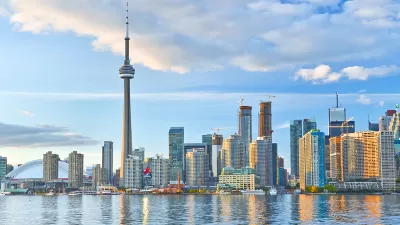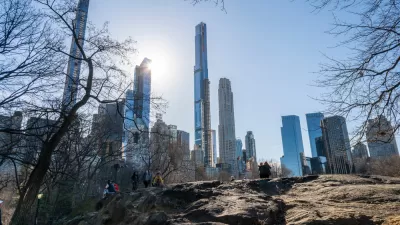No skyline in North America has changed as drastically as Toronto’s in recent decades. A slate of new skyscraper proposals, called a “skyscraper race” by observers, could continue the trend.

Developer Pinnacle International is proposing two supertall skyscrapers—one at 92 stories and other at 105 stories—potentially rising among the two or three tallest buildings in the city.
Pinnacle is seeking an increase in height for both buildings, already approved at heights 12 and ten stories shorter, respectively, at the current site of the Toronto Star building. If approved at the newly proposed heights, the buildings would jump past the approved development of “The One,” proposed for the corner of Yonge and Bloor.
The taller of Pinnacle’s two buildings, called SkyTower, would reach 346 meters (just over 1,135 feet). SkyTower would be the first building in Canada to exceed 100 stories.
A paywalled article by May Warren, linked below, provides more local commentary on the city’s new skyscraper race. As noted by Warren, the city’s famous CN Tower, which reaches 553 meters (1,815 feet) doesn’t qualify for the discussion, though it is much taller than any of the buildings reported here.
“The CN Tower doesn’t technically count as a building, he added. According to the Council on Tall Buildings and Urban Habitat, to be considered a building at least half of its height must be occupiable. Telecommunications or observation towers don’t make the cut,” writes Warren.
Toronto has long outpaced all other North American cities in the scope of skyscraper construction. Planetizen documented Toronto’s development pace with articles in 2015 and 2012.
FULL STORY: In the race to build Toronto’s first ‘super tall’ skyscraper, a new proposal hits 105 storeys [paywall]

Study: Maui’s Plan to Convert Vacation Rentals to Long-Term Housing Could Cause Nearly $1 Billion Economic Loss
The plan would reduce visitor accommodation by 25,% resulting in 1,900 jobs lost.

Placekeeping: Setting a New Precedent for City Planners
How a preservation-based approach to redevelopment and urban design can prevent displacement and honor legacy communities.

Using Old Oil and Gas Wells for Green Energy Storage
Penn State researchers have found that repurposing abandoned oil and gas wells for geothermal-assisted compressed-air energy storage can boost efficiency, reduce environmental risks, and support clean energy and job transitions.

Washington State Plans Ambitious ‘Cycle Highway’ Network
The state is directing funding to close gaps in its existing bike network and make long-distance trips more accessible.

Homeowners Blame PG&E for Delays in ADU Permits
The utility says it has dramatically reduced its backlog, but applicants say they still face months-long delays for approvals for new electrical work.

Rethinking Wildfire Defense: How a Landscape Approach Can Protect Neighborhoods
Post-fire analysis of the Eaton Fire reveals that a landscape approach — including fire-resistant vegetation, home hardening, and strategic planning — can help reduce wildfire risk, challenging assumptions that trees and plants are primary fire hazards.
Urban Design for Planners 1: Software Tools
This six-course series explores essential urban design concepts using open source software and equips planners with the tools they need to participate fully in the urban design process.
Planning for Universal Design
Learn the tools for implementing Universal Design in planning regulations.
Borough of Carlisle
Caltrans
Heyer Gruel & Associates PA
Institute for Housing and Urban Development Studies (IHS)
City of Grandview
Harvard GSD Executive Education
Salt Lake City
NYU Wagner Graduate School of Public Service
City of Cambridge, Maryland





























